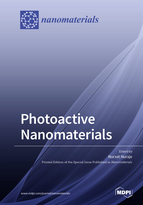Photoactive Nanomaterials
A special issue of Nanomaterials (ISSN 2079-4991). This special issue belongs to the section "Synthesis, Interfaces and Nanostructures".
Deadline for manuscript submissions: closed (1 January 2021) | Viewed by 44529
Special Issue Editor
2. Department of Chemical and Materials Engineering, School of engineering and Digital Science, Nazarbayev University, 53 Kabanbay Batyr Ave, Nursultan, Kazakhstan
Interests: nanomaterials; photocatalyst; solar energy conversion; zwitterionic polymers
Special Issue Information
Dear Colleagues,
The aim of this Special Issue is to deliver recent research progress in the field of photoactive nanomaterials to the scientific community. This Special Issue focuses on photoactive nanomaterials from fundamental research to their applications. Included are the fundamental study of photoactive nanomaterials in solar energy conversion starting with light harnessing, charge separation/recombination, and catalytic reaction kinetics, as well as their various applications including energy, environmental, and catalytic. Applications in the energy field include photovoltaic use, as well as fuel generation from watersplitting, biomass, carbon dioxide, nitrogen conversion, etc. Environmental applications include photo degradation of organic and inorganic pollutants. Some examples of catalytic applications include photocatalytic conversion of biomass-derived platform molecules, carbon dioxide, and nitrogen. The application of the photoactive nanomaterials is not limited to the above three fields. The fundamental study of photoactive nanomaterials can experimental and theoretical investigations of solar energy conversion, including photovoltaic and photocatalytic mechanisms using different simulation software from material design to reaction kinetics. The scope of this Special Issue can have photoactive nanomaterial synthesis, a basic study of the solar energy conversion process with simulations, and applications including environmental, catalytic, photovoltaic, and solar fuel generation. Other research areas of photoactive nanomaterials are also welcomed. Manuscripts can be review, research and communications.
Dr. Nurxat Nuraje
Guest Editor
Manuscript Submission Information
Manuscripts should be submitted online at www.mdpi.com by registering and logging in to this website. Once you are registered, click here to go to the submission form. Manuscripts can be submitted until the deadline. All submissions that pass pre-check are peer-reviewed. Accepted papers will be published continuously in the journal (as soon as accepted) and will be listed together on the special issue website. Research articles, review articles as well as short communications are invited. For planned papers, a title and short abstract (about 100 words) can be sent to the Editorial Office for announcement on this website.
Submitted manuscripts should not have been published previously, nor be under consideration for publication elsewhere (except conference proceedings papers). All manuscripts are thoroughly refereed through a single-blind peer-review process. A guide for authors and other relevant information for submission of manuscripts is available on the Instructions for Authors page. Nanomaterials is an international peer-reviewed open access semimonthly journal published by MDPI.
Please visit the Instructions for Authors page before submitting a manuscript. The Article Processing Charge (APC) for publication in this open access journal is 2900 CHF (Swiss Francs). Submitted papers should be well formatted and use good English. Authors may use MDPI's English editing service prior to publication or during author revisions.
Keywords
- photocatalyst
- photoelectrochemical cell
- charge separation
- light harnessing
- cocatalyst
- solar to hydrogen efficiency
- hydrogen generation







